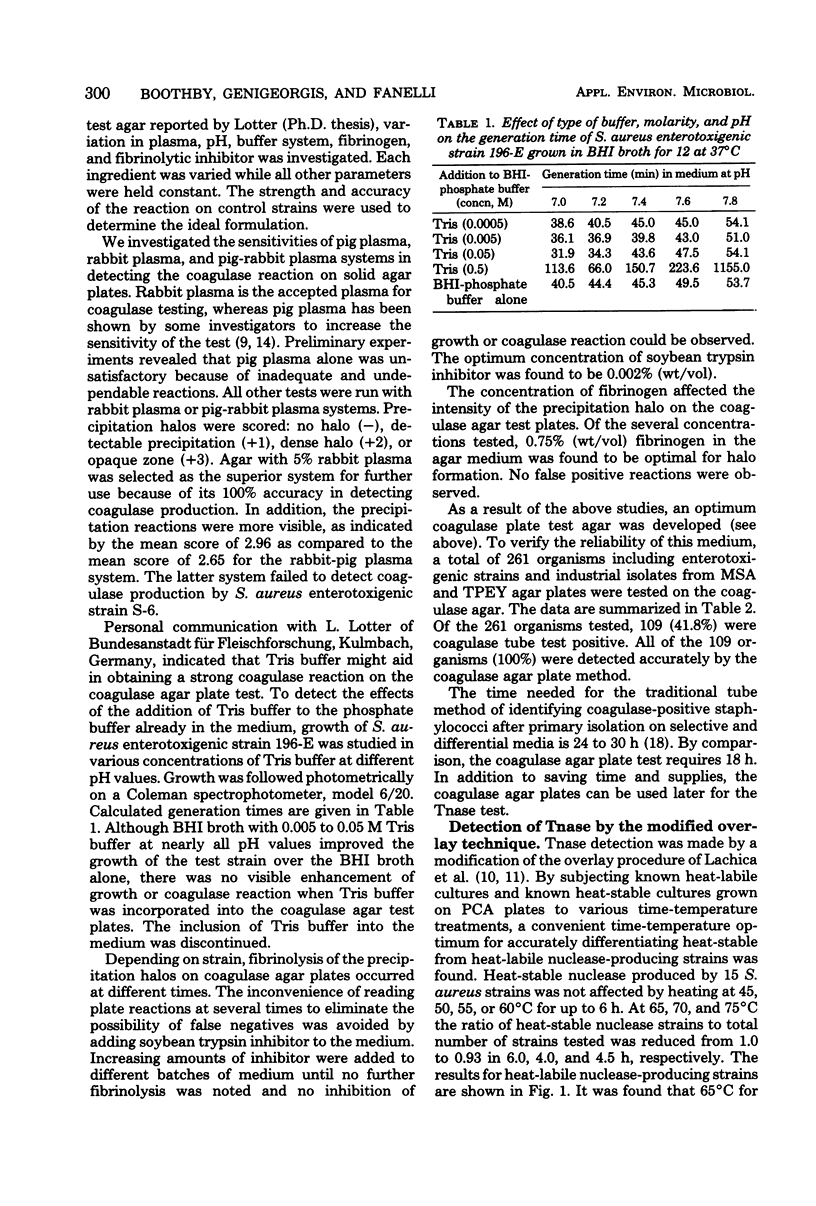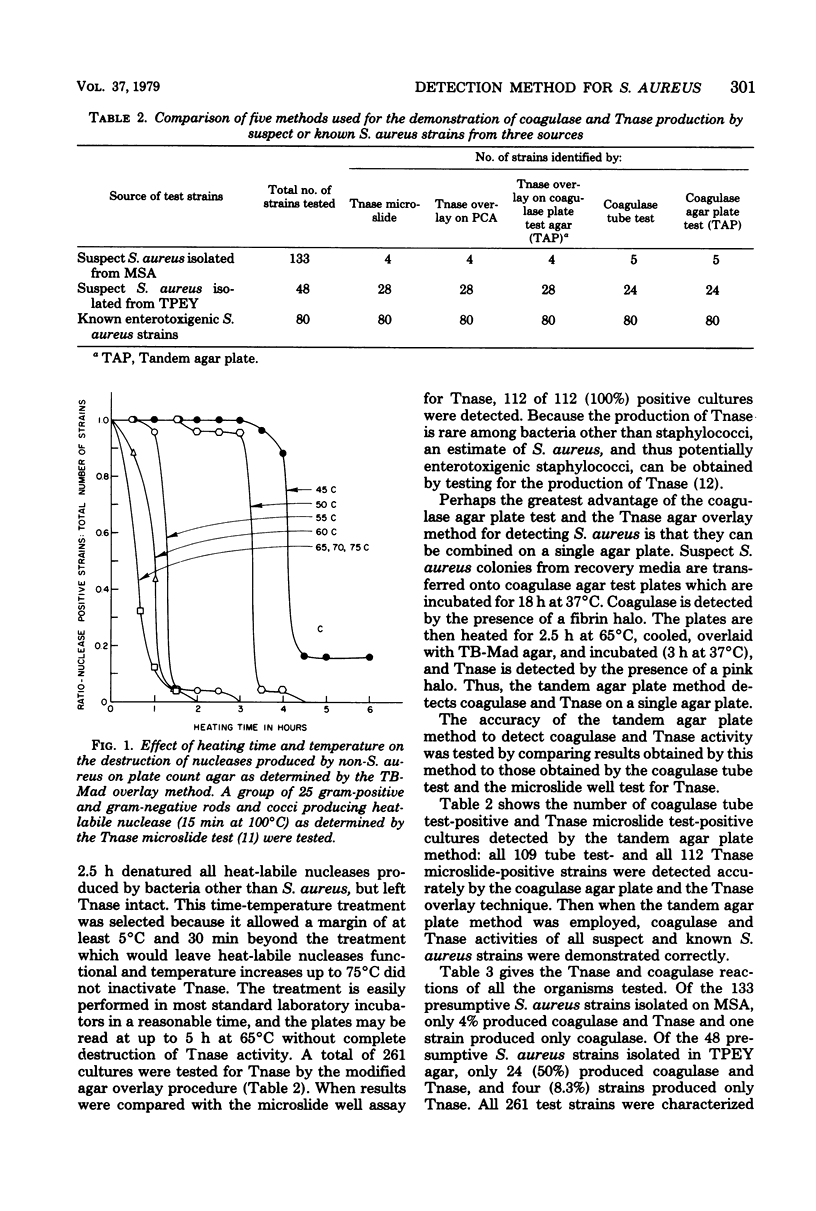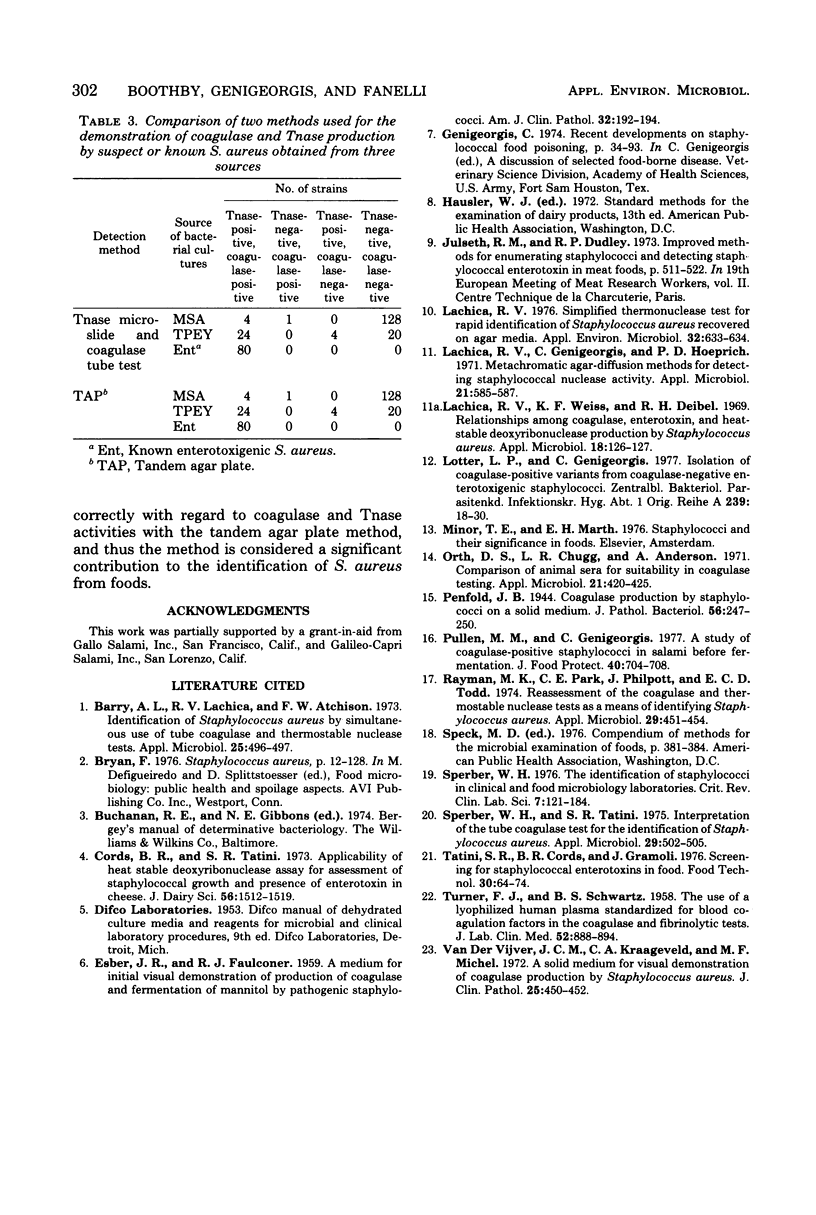Abstract
In optimizing previously reported coagulase agar media to obtain a rapid, reliable, and inexpensive coagulase test agar, variations in plasmas, pH, buffer system, fibrinogen, and fibrinolytic inhibitor were investigated. The agar with the following composition was determined best for the demonstration of coagulase production by Staphylococcus aureus: 25 ml of 15% bovine fibrinogen (fraction I, type I, citrated, Sigma Chemical Co.), 25 ml of rehydrated rabbit plasma (coagulase plasma ethylenediaminetetraacetic acid, Difco), 10.0 mg of soybean trypsin inhibitor (Schwarz/Mann), and 450 ml of brain heart infusion agar (Difco). In additional studies involving 7 different temperatures and 11 heating times, the thermal destruction of microbial nucleases on plate count agar and coagulase test agar was investigated. Heating the plates for 2.5 h at 65°C destroyed all heatlabile nucleases, but not thermonucleases of S. aureus. A tandem agar plate method for the identification of S. aureus was developed. Coagulase and thermonuclease activity of 50 colonies can be detected on a single agar plate. Suspect S. aureus colonies isolated on various selective media are transferred to coagulase test agar, the plates are incubated at 37°C for 18 h, and the coagulase reaction is recorded. The plates are then heated at 65°C for 2.5 h, overlaid with toluidine blue-metachromatic diffusion agar, and reincubated at 37°C for 3 h, and the thermonuclease reaction is recorded. Studies based on 88 enterotoxigenic S. aureus strains and 133 and 48 suspect S. aureus strains isolated from fresh salami mixtures on mannitol salt and tellurite-polymyxin-egg yolk agars, respectively, demonstrated 100% agreement between the tandem agar plate method and standard coagulase and thermonuclease tests. Overall, the tandem agar plate method is a rapid and convenient approach contributing to the identification of S. aureus from foods.
Full text
PDF




Selected References
These references are in PubMed. This may not be the complete list of references from this article.
- Barry A. L., Lachica R. V., Atchison F. W. Identification of Staphylococcus aureus by simultaneous use of tube coagulase and thermonuclease tests. Appl Microbiol. 1973 Mar;25(3):496–497. doi: 10.1128/am.25.3.496-497.1973. [DOI] [PMC free article] [PubMed] [Google Scholar]
- Cords B. R., Tatini S. R. Applicability of heat-stable deoxyribonuclease assay for assessment of staphylococcal growth and the likely presence of enterotoxin in cheese. J Dairy Sci. 1973 Dec;56(12):1512–1519. doi: 10.3168/jds.S0022-0302(73)85400-1. [DOI] [PubMed] [Google Scholar]
- Lachica R. V., Genigeorgis C., Hoeprich P. D. Metachromatic agar-diffusion methods for detecting staphylococcal nuclease activity. Appl Microbiol. 1971 Apr;21(4):585–587. doi: 10.1128/am.21.4.585-587.1971. [DOI] [PMC free article] [PubMed] [Google Scholar]
- Lachica R. V. Simplified thermonuclease test for rapid identification of Staphylococcus aureus recovered on agar media. Appl Environ Microbiol. 1976 Oct;32(4):633–634. doi: 10.1128/aem.32.4.633-634.1976. [DOI] [PMC free article] [PubMed] [Google Scholar]
- Lotter L. P., Genigeorgis C. A. Isolation of coagulase-positive variants from coagulase-negative enterotoxigenic staphylococci. Zentralbl Bakteriol Orig A. 1977 Sep;239(1):18–30. [PubMed] [Google Scholar]
- Orth D. S., Chugg L. R., Anderson A. W. Comparison of animal sera for suitability in coagulase testing. Appl Microbiol. 1971 Mar;21(3):420–425. doi: 10.1128/am.21.3.420-425.1971. [DOI] [PMC free article] [PubMed] [Google Scholar]
- Rayman M. K., Park C. E., Philpott J., Todd E. C. Reassessment of the coagulase and thermostable nuclease tests as means of identifying Staphylococcus aureus. Appl Microbiol. 1975 Apr;29(4):451–454. doi: 10.1128/am.29.4.451-454.1975. [DOI] [PMC free article] [PubMed] [Google Scholar]
- Sperber W. H., Tatini S. R. Interpretation of the tube coagulase test for identification of Staphylococcus aureus. Appl Microbiol. 1975 Apr;29(4):502–505. doi: 10.1128/am.29.4.502-505.1975. [DOI] [PMC free article] [PubMed] [Google Scholar]
- Sperber W. H. The identification of staphylococci in clinical and food microbiology laboratories. CRC Crit Rev Clin Lab Sci. 1976;7(2):121–184. doi: 10.3109/10408367709151577. [DOI] [PubMed] [Google Scholar]
- TURNER F. J., SCHWARTZ B. S. The use of a lyophilized human plasma standardized for blood coagulation factors in the coagulase and fibrinolytic tests. J Lab Clin Med. 1958 Dec;52(6):888–894. [PubMed] [Google Scholar]
- Victor R., Lachica F., Weiss K. F., Deibel R. H. Relationships among coagulase, enterotoxin, and heat-stable deoxyribonuclease production by Staphylococcus aureus. Appl Microbiol. 1969 Jul;18(1):126–127. doi: 10.1128/am.18.1.126-127.1969. [DOI] [PMC free article] [PubMed] [Google Scholar]
- van der Vijver J. C., Kraayeveld C. A., Michel M. F. A solid medium for visual demonstration of coagulase production by Staphylococcus aureus. J Clin Pathol. 1972 May;25(5):450–452. doi: 10.1136/jcp.25.5.450. [DOI] [PMC free article] [PubMed] [Google Scholar]


